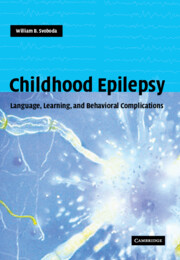Book contents
- Frontmatter
- Contents
- Preface
- Glossary
- 1 Looking ahead
- Part I Speech and language problems
- Part II Learning problems
- Part III Behavior problems
- 27 Mental health needs
- 28 Psychologic development
- 29 Seizure types and modifying factors
- 30 Overview: extrinsic factors
- 31 Behavior problems: general
- 32 Attention deficit disorders
- 33 Anxiety disorders
- 34 Mood disorders
- 35 Disruptive behavior problems
- 36 Psychoses of epilepsy
- 37 Non-epileptic events
- 38 Possible treatment issues
- 39 Helping with psychiatric problems
- 40 Epilog
- Index
- References
32 - Attention deficit disorders
from Part III - Behavior problems
Published online by Cambridge University Press: 26 October 2009
- Frontmatter
- Contents
- Preface
- Glossary
- 1 Looking ahead
- Part I Speech and language problems
- Part II Learning problems
- Part III Behavior problems
- 27 Mental health needs
- 28 Psychologic development
- 29 Seizure types and modifying factors
- 30 Overview: extrinsic factors
- 31 Behavior problems: general
- 32 Attention deficit disorders
- 33 Anxiety disorders
- 34 Mood disorders
- 35 Disruptive behavior problems
- 36 Psychoses of epilepsy
- 37 Non-epileptic events
- 38 Possible treatment issues
- 39 Helping with psychiatric problems
- 40 Epilog
- Index
- References
Summary
Attention deficit disorders, with or without hyperactivity (ADD/ADDH, or ADHD), are a collection of similar behaviors caused by a wide variety of problems. Recognition of the cause is necessary to treat the problems effectively. Experts cannot agree on the cause, the diagnosis, the treatment, or the prevention. Some experts doubt their existence. The knowledge about the disorders remains speculative. It is unclear whether ADHD is at the far end of the continuum of normal behavior or whether it reflects a qualitatively different behavior syndrome. The symptoms have a CNS basis. There is some evidence of validity, but more study of this is needed (National Institutes of Health, 2000).
ADDs are frequent in children and adults with partial seizure disorders, but they may also occur in primary generalized epilepsy. ADD is seen in up to 48% of children with epilepsy, especially in boys (Holdsworth & Whitmore, 1974). Epileptic students show reduced alertness (Bennet-Levy & Stores, 1984).
Barry (1998) reviewed the treatment of attention disorders for the American Epilepsy Society Conference. Symptoms include a short attention span or distractibility, impulsive behavior, and poor frustration tolerance. Motor hyperactivity may be present. This may precede epilepsy. It occurs in one-third of children with epilepsy. ADD among patients with epilepsy can be confused with a dysphoria of epilepsy and can be mimicked by associated learning disabilities that interfere with auditory processing as well as by frequent absence seizures. Symptoms of ADD may be a side effect of antiepileptic drugs, especially in patients with retardation.
- Type
- Chapter
- Information
- Childhood EpilepsyLanguage, Learning and Behavioural Complications, pp. 477 - 493Publisher: Cambridge University PressPrint publication year: 2004



